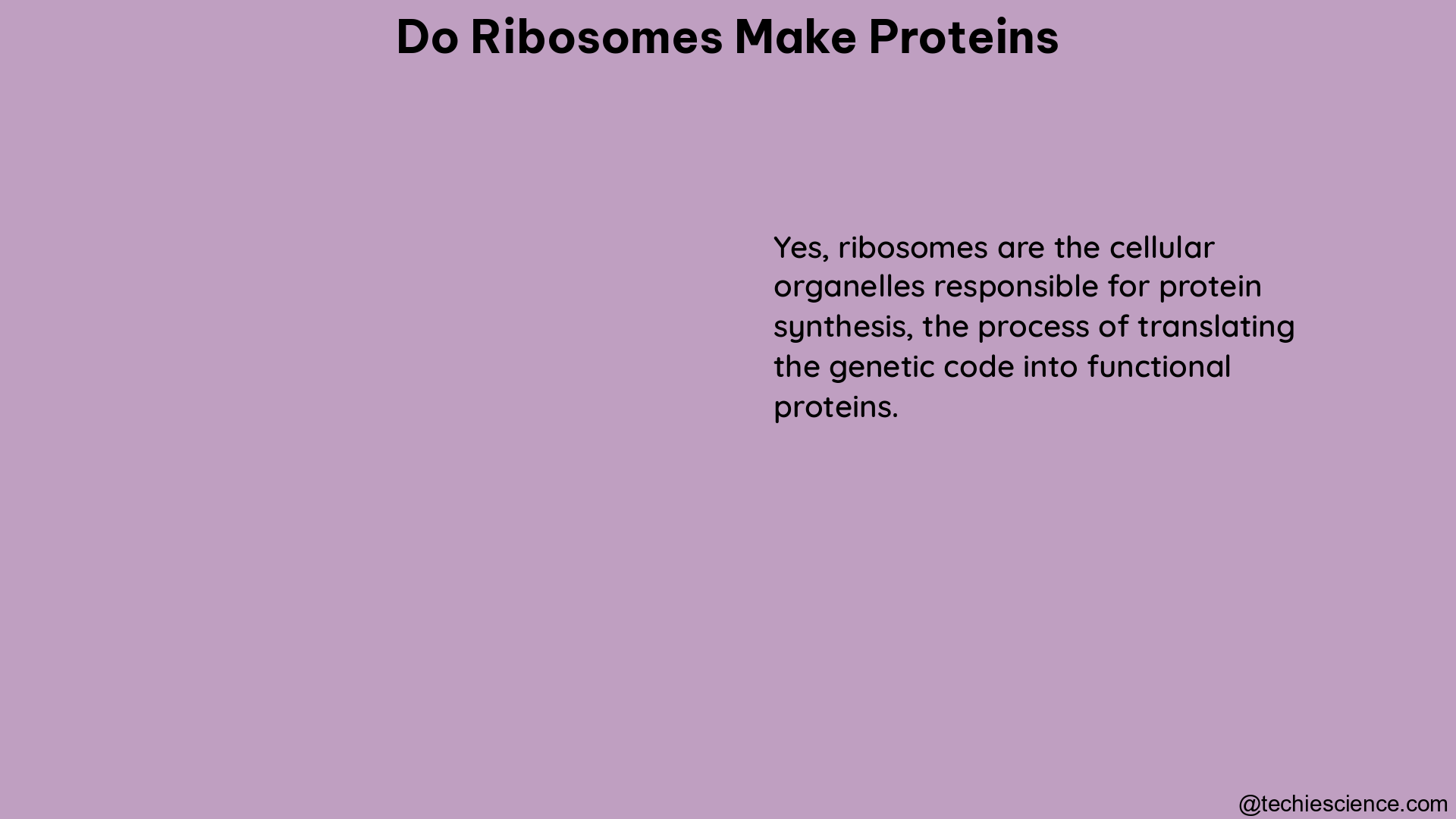Ribosomes are the cellular factories responsible for the synthesis of proteins, the fundamental building blocks of life. These complex molecular machines are present in both prokaryotic and eukaryotic cells, playing a crucial role in the translation of genetic information into functional proteins. In this comprehensive guide, we will delve into the intricate mechanisms of how ribosomes manufacture proteins, the techniques used to study this process, and the quantitative insights that can be gained from these analyses.
The Ribosome: Structure and Function
Ribosomes are composed of two subunits, the small subunit (30S in prokaryotes, 40S in eukaryotes) and the large subunit (50S in prokaryotes, 60S in eukaryotes). These subunits come together to form the complete ribosome (70S in prokaryotes, 80S in eukaryotes), which serves as the site of protein synthesis.
The ribosome’s structure is highly complex, consisting of numerous ribosomal proteins and ribosomal RNA (rRNA) molecules. The small subunit is responsible for decoding the genetic information carried by messenger RNA (mRNA), while the large subunit catalyzes the formation of peptide bonds between amino acids, ultimately assembling the polypeptide chain.
The process of protein synthesis can be divided into three main stages:
- Initiation: The ribosome binds to the mRNA at the start codon, positioning the first amino acid (methionine) in the peptidyl (P) site.
- Elongation: The ribosome moves along the mRNA, adding one amino acid at a time to the growing polypeptide chain. This is facilitated by transfer RNAs (tRNAs) that carry specific amino acids and bind to their complementary codons on the mRNA.
- Termination: When the ribosome reaches a stop codon on the mRNA, the completed polypeptide chain is released, and the ribosome disassembles.
Ribosome Profiling: Studying Protein Synthesis

Ribosome profiling, also known as Ribo-seq, is a powerful technique that allows researchers to study the dynamics of protein synthesis in living cells. This method involves the following steps:
- Ribosome Arrest: The translation elongation process is arrested, typically using a drug or low temperature, to “freeze” the ribosomes in their positions on the mRNA.
- mRNA Fragmentation: The mRNA associated with the arrested ribosomes is fragmented, leaving behind only the ribosome-protected mRNA fragments.
- Ribosome-protected Fragment Sequencing: The ribosome-protected mRNA fragments are then isolated, purified, and sequenced using high-throughput sequencing technologies.
- Data Analysis: The sequenced fragments are aligned to a reference genome or transcriptome, and the position of the ribosome’s A-site (where the codon is translated) is identified on each fragment.
By analyzing the distribution of ribosome-protected fragments along the mRNA, researchers can extract valuable information about the translation process, such as:
- Translation Initiation Rates: The density of ribosome-protected fragments at the start codon can provide insights into the efficiency of translation initiation.
- Codon Translation Rates: The number of ribosome-protected fragments aligned to a particular codon reflects the time it takes for the ribosome to translate that codon, known as the codon translation rate.
- Ribosome Occupancy: The overall distribution of ribosome-protected fragments along the mRNA can reveal the steady-state occupancy of ribosomes on the transcript, indicating the translation efficiency.
Quantifying Protein Synthesis Rates
Ribosome profiling data can be used to quantify the rates of protein synthesis, providing valuable insights into the kinetic control of gene expression. Here are some key metrics and calculations:
-
ATP Consumption: It is estimated that protein synthesis requires about 1/4 of the total ATP consumption in a mammalian cell. Additionally, the elongation of one amino acid requires approximately 5 ATP molecules.
-
Amino Acid Elongation Rate: Based on the ATP consumption data, it is estimated that around 5 mol of amino acids are elongated per day in a mammalian cell.
-
Amino Acids Synthesized per Hour: Considering the ATP consumption and the average length of a human protein (400 amino acids), it is estimated that approximately $1.2 \times 10^{23}$ amino acids are synthesized per hour in the human body.
-
Proteins Synthesized per Hour: Given the average human protein length of 400 amino acids, the estimated number of proteins synthesized per hour in the human body is around $3 \times 10^{20}$.
These quantitative estimates provide a glimpse into the remarkable efficiency and scale of protein synthesis orchestrated by the ribosomes within our cells.
Computational Modeling of Protein Synthesis
The accurate determination of translation initiation and codon translation rates from ribosome profiling data is crucial for the development of computational models of protein synthesis. These models can help researchers gain deeper insights into the kinetic control of gene expression and the underlying principles governing the allocation of cellular resources.
By incorporating the rate parameters extracted from ribosome profiling experiments, computational models can simulate the dynamics of protein synthesis, including:
- Protein Abundance Prediction: The models can predict the steady-state levels of proteins based on the translation initiation and codon translation rates.
- Translational Regulation: The models can elucidate how various factors, such as mRNA secondary structures, codon usage, and regulatory elements, influence the translation process.
- Cellular Resource Allocation: The models can provide insights into how cells allocate their resources, such as ribosomes and amino acids, to optimize protein synthesis and maintain cellular homeostasis.
These computational approaches, combined with the experimental data from ribosome profiling, offer a powerful framework for understanding the complex mechanisms underlying protein synthesis in living cells.
Conclusion
In summary, ribosomes are the essential cellular machines responsible for the synthesis of proteins, the fundamental building blocks of life. Through the process of translation, ribosomes decode the genetic information carried by mRNA and assemble the polypeptide chain, one amino acid at a time.
Ribosome profiling, a cutting-edge experimental technique, allows researchers to study the dynamics of protein synthesis in unprecedented detail. By analyzing the distribution of ribosome-protected mRNA fragments, scientists can extract valuable information about translation initiation rates, codon translation rates, and ribosome occupancy, providing quantitative insights into the kinetic control of gene expression.
Furthermore, the data obtained from ribosome profiling experiments can be integrated into computational models of protein synthesis, enabling researchers to simulate the dynamics of this crucial cellular process and gain a deeper understanding of the principles governing the allocation of cellular resources.
As our understanding of the intricate mechanisms of protein synthesis continues to evolve, the insights gained from the study of ribosomes and their role in protein synthesis will undoubtedly lead to advancements in fields ranging from molecular biology to biotechnology and medicine.
References:
- Tunney, R., McGlincy, N. J., Graham, M. E., Naddaf, N., Pachter, L., & Lareau, L. F. (2018). Accurate Design of Ribosome Profiling Experiments. Cell Systems, 7(1), 67–78.e4. https://doi.org/10.1016/j.cels.2018.06.002
- How many proteins do all human ribosomes together produce per hour? (2016, November 16). BioStackexchange. https://biology.stackexchange.com/questions/53428/how-many-proteins-do-all-human-ribosomes-together-produce-per-hour
- Li, G-W., Burkhardt, D., Gross, D., & Weissman, J. S. (2014). Quantifying Absolute Protein Synthesis Rates Reveals Principles Underlying Allocation of Cellular Resources. Cell, 157(2), 324–335. https://doi.org/10.1016/j.cell.2014.03.042
- Yadav, V., Irshad, I. U., Kumar, H., & Sharma, A. K. (2021). Quantitative Modeling of Protein Synthesis Using Ribosome Profiling Data. Frontiers in Molecular Biosciences, 8, 655602. https://doi.org/10.3389/fmolb.2021.655602
- Ingolia, N., Lareau, L. F., & Weissman, J. S. (2014). Ribosome profiling: a new view of translation. Nature Structural & Molecular Biology, 21(3), 261–266. https://doi.org/10.1038/nsmb.2753

Hello, I am Piyali Das, pursuing my Post Graduation in Zoology from Calcutta University. I am very passionate on Academic Article writing. My aim is to explain complex things in simple way through my writings for the readers.